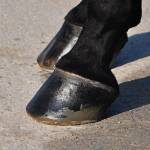Equine Laminitis: New Approach to Treatment

An intensely painful condition, particularly in acute cases, laminitis can result in sinking and rotation of the coffin bone and in difficulty controlling pain. Here is a review of some laminitis basics and a peek at a new approach researchers are exploring to help find a more effective treatment for laminitis.
Laminitis Basics
Despite carrying the weight of the entire horse, the hoof is an exquisitely delicate structure. The hoof houses the coffin bone, also called the third phalanx or P3. Interdigitating, finger-like attachments stemming from tissue called the stratum internum or lamellae help hold the coffin bone in place within the hoof.
“Damage to the lamellae caused by inflammation can disrupt those finger-like attachments between the coffin bone and the inner aspect of the hoof. The weakened structure results in the coffin bone slipping toward the ground and rotating backward due to the pull of the deep digital flexor tendon that fastens to the coffin bone,” explained Catherine Whitehouse, M.S., a nutrition advisor for Kentucky Equine Research.
The body attempts to repair the damaged tissues that hold together the hoof wall and coffin bone but falls short of its goal. The repair tissue is poorly organized and therefore weaker than the original, undamaged tissues.
New Treatment Option
The hoof wall grows from the coronary band. Similarly, the cells involved in fastening the inner hoof wall to the coffin bone also stem from the coronary band. Specifically, they are produced by progenitor cells located in the stratum internum of the coronary band.
“Progenitor cells are similar to stem cells in that they can produce cells that have the ability to differentiate into various cell types. This includes ‘ectodermal cells’ located on the hoof side of the hoof-coffin bone interface, as well as ‘mesodermal cells’ located on the coffin bone side of the attachment,” Whitehouse described.
“This is similar to what occurs in the nail beds of humans,” she added.
Orthopedic researchers from Louisiana State University School of Veterinary Medicine* recently explored the possibility of collecting progenitor cells from the coronary bands of horses to study them in laboratory cultures.
The researchers noted that “a mechanism to confidently isolate and culture hoof progenitor cells from the ectodermal-mesodermal tissue niche of normal and chronically inflamed hooves will provide a useful tool to evaluate mechanisms of cell damage and target therapies to prevent cell loss and restore normal growth following injury, local disease, or systemic pathology.”
The researchers successfully collected and cultured the progenitor cells. They found that the cultured cells maintained their ability to produce additional cells that had both ectodermal and mesodermal qualities, all of which are necessary to bind the coffin bone to the hoof wall. They therefore suggested their culture technique allows researchers to explore targeted preventive and therapeutic approaches to laminitis.
“This exciting development in laminitis research will benefit scores of horses that develop this painful, life-threatening condition and potentially prevent it in at-risk horses,” Whitehouse noted.
Currently, one mode of prevention involves offering a balanced diet low in nonstructural carbohydrates, particularly in carbohydrate-sensitive horses (e.g., those with equine metabolic syndrome, insulin dysregulation, and easy keepers). Diets containing less than 10-12% nonstructural carbohydrates are recommended. In addition, maximize hoof health by offering Bio-Bloom PS (Bio-Bloom HF in Australia) containing methionine, iodine, and chelated zinc to improve hoof quality and speed growth, as well as lecithin and essential fatty acids from full-fat soybeans.
*Yang, Q., V.M.R. Pinto, W. Duan, et al. 2019. In vitro characteristics of heterogeneous equine hoof progenitor cell isolates. Frontiers in Bioengineering and Biotechnology. 7:155.








